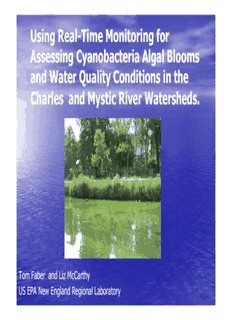
Using Real-Time Monitoring for Assessing Cyanobacteria Algal PDF
Preview Using Real-Time Monitoring for Assessing Cyanobacteria Algal
Using Real-Time Monitoring for Assessing Cyanobacteria Algal Blooms and Water Quality Conditions in the Charles and Mystic River Watersheds. Tom Faber and Liz McCarthy US EPA New England Regional Laboratory Charles and Mystic River Real-Time Monitoring EPA New England Regional Laboratory The Real-Time Monitoring Buoys are off-line for the season Purpose: Environmental Protection Agency (EPA) has established monitoring buoys in the Charles and Mystic Watersheds. These buoys collect and transmit water quality data that is available to the public. EPA has established these buoys to help with the tracking of cyanobacteria blooms and water quality conditions. Note: All water quality measurements are collected 1 meter below the water's surface Last Sonde Verification: 9/29/2011 Project Partners: Click here Disclaimer: The data presented on this website is considered preliminary data and may be subject to future revision or qualifiers. The data from this site is transmitted directly from the instrument with no or little review. Inaccuracies may be presented because instrument malfunction or physical changes at buoy location. Sonde Measurements • Recorded every 15 minutes • Charles measurement period 6/06-9/26/11 • Spy Pond measurement period 6/16-9/29/11 • Measurements collected at 1 meter depth • Parameters – Temperature, – Conductivity – pH – Dissolved oxygen – Turbidity – Chlorophyll – Phycocyanin Field Samples collected and processed for Chlorophyll a and Phycocyanin Buoy chlorophyll and phycocyanin correlated with Lab data • Chlorophyll a – EPA lab EPA Ref. method 445 (Dick Siscanaw EPA Chemist) • Cyanobacteria cell counts – EPA Contract lab – DPH data Phycocyanin probe correlation with Laboratory Cyanobacteria cell counts Buoy Phycocyanin vs Cyanobacteria Cell Buoy Phycocyanin Vs. DPH cyanobacteria cell 80000 Buoy Phycocyanin Vs. DPH cyano cell counts Counts (GW lab) counts (without 8/8/11) )7000070000 70000 L m y = 13.429x -)13595 ells/L)6000060000 y = 4.4368x -R4²4=5.05.46s/mL46yyyyy6=====00444440.....044444333336666688888xxxxx ----- 444444444455555.....5555544444 (cm R² = 0.7231 ell RRRRR²²²²² ===== 00000.....77777222223333311111 ountscells/5000050000 nts(c 50000 c( u iaCellacteria34000000003400000000 Cellco 40000 y = 2.R3²21=4x0.+3751889.7 rb bacteyano2000020000 cteria 30000 oC a nH b 20000 a o yP n CD1000010000 a y C 10000 H 0 0 P D 0 0 10002000 2000 40003000 60004000 80005000 100006000 120070000 14000 0 BuoyBPuhoyycPochyyacnoicnyCaonninceCnotnracteionntrsa(tcioelnlss/(mceLl)ls/mL) 0 5000 10000 15000 20000 Buoy Phycocyanin Concentrations (cells/mL) Note: DPH samples collected ~35 feet away at dock 6” deep
Description: